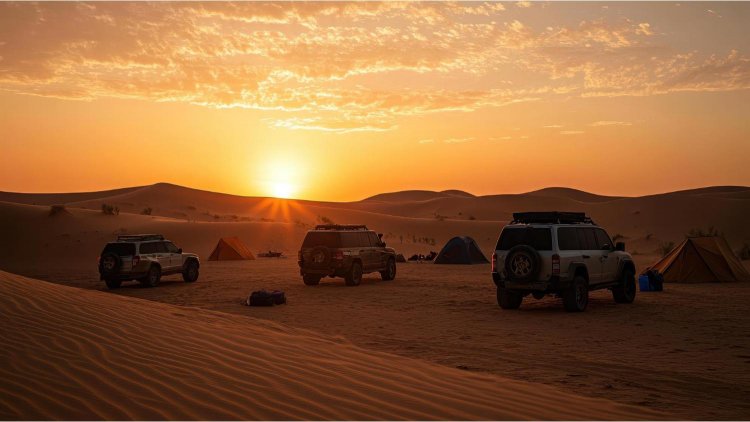Embracing the Arid Frontier: 10 Essential Travel Tips for Exploring Remote Desert Landscapes
Exploring the remote deserts of the world can be a transformative experience. The vast, arid expanses offer a unique combination of natural beauty, solitude, and adventure that few other landscapes can match. However, traveling in these extreme environments requires careful preparation and awareness. Here are ten indispensable travel tips for navigating and enjoying remote desert landscapes.

1. Plan Your Journey with Precision
Traveling to remote desert regions requires meticulous planning. Deserts are often far from major cities, so logistical considerations are crucial. Start by researching the specific desert you plan to visit. Each desert has its own climate, terrain, and potential hazards. Understand the best times to visit, as temperatures can vary drastically between seasons.
Create a detailed itinerary, including travel routes, accommodation options, and fuel stations. In many remote areas, services can be sparse, so ensure you have a clear plan for where you'll stay and how you'll navigate the terrain. Consider using GPS devices and offline maps, as cell phone reception can be unreliable.
2. Master the Art of Hydration
Hydration is critical in desert environments, where temperatures can soar and humidity is often low. Plan to drink more water than you would in a more temperate climate. The general rule of thumb is to drink at least one gallon (3.8 liters) of water per person per day, but you may need more depending on your activity level and the temperature.
Carry extra water supplies and have a backup plan for replenishing your water supply. Water purification tablets or filters are also useful in case you need to source water from natural sources. Be mindful of symptoms of dehydration, such as dizziness, dry mouth, and dark-colored urine, and take proactive measures to stay hydrated.
3. Dress for Success
Clothing plays a significant role in your comfort and safety in the desert. Wear lightweight, breathable fabrics that wick away sweat and provide sun protection. Long sleeves and long pants are recommended to shield your skin from the harsh sun and potential insect bites.
A wide-brimmed hat, sunglasses with UV protection, and a good pair of hiking boots are essential. The hat will shield your face and neck from the sun, while sunglasses protect your eyes from glare. Choose footwear that offers support and can handle rugged terrain.
4. Embrace the Sun Smartly
The desert sun can be relentless, so it’s important to take precautions to protect yourself from sunburn and heatstroke. Apply sunscreen with a high SPF regularly, especially if you’re spending extended periods outdoors. Opt for water-resistant formulas if you’re sweating heavily or engaging in water activities.
Seek shade during the hottest parts of the day, typically between 10 a.m. and 4 p.m. Plan outdoor activities for early morning or late afternoon when temperatures are cooler. Staying cool and protected from the sun helps prevent heat-related illnesses and ensures a more enjoyable experience.
5. Navigate the Terrain Safely
Desert landscapes can be challenging to navigate due to their vastness and often featureless terrain. Equip yourself with proper navigation tools, including a compass, GPS device, and detailed maps. Familiarize yourself with the local geography and landmarks before heading out.
When driving in remote desert areas, ensure your vehicle is in good condition and equipped for off-road conditions. Carry essential supplies such as a spare tire, jack, and emergency tools. If you’re traveling with a group, stick together and maintain regular communication to avoid getting separated.
6. Understand the Wildlife
Desert wildlife can be fascinating but also potentially dangerous. Research the types of animals you might encounter, such as snakes, scorpions, and spiders. Learn about their habits and how to avoid conflicts. For instance, avoid reaching into dark crevices where snakes might be hiding.
If you’re camping or spending time outdoors, take precautions to avoid attracting wildlife. Store food securely and keep your campsite clean. Understanding and respecting desert wildlife will enhance your experience and help ensure your safety.
7. Prepare for Extreme Temperature Variations
Deserts are known for their extreme temperature fluctuations between day and night. While daytime temperatures can be scorching, nights can become unexpectedly cold. Pack clothing that allows you to adapt to these temperature changes. Layering is key—wear moisture-wicking base layers, insulating layers for warmth, and outer layers for protection from the elements.
A good sleeping bag designed for cold temperatures is also essential if you plan to camp. Ensure your camping gear can handle the temperature range you’ll encounter. Being prepared for these extremes will keep you comfortable and safe throughout your journey.
8. Respect Local Cultures and Environments
Many deserts are home to indigenous cultures with deep historical and cultural significance. Approach these communities with respect and sensitivity. Learn about their customs, traditions, and ways of life before visiting. When interacting with locals, be mindful of their privacy and personal space.
Additionally, respect the natural environment by following Leave No Trace principles. Avoid disturbing wildlife, stay on designated trails, and pack out all your trash. Preserving the pristine beauty of desert landscapes ensures that future travelers can enjoy them as well.
9. Prepare for Emergencies
Desert environments can be unforgiving, and emergencies can arise. Carry a well-stocked first aid kit, including items specific to desert conditions like snakebite kits and sunburn treatments. Familiarize yourself with basic first aid procedures and how to respond to common desert-related injuries and ailments.
Have an emergency plan in place, including contacts for local emergency services and a way to communicate if you’re out of cell phone range. It’s also wise to inform someone of your travel plans and expected return time. Preparation and foresight are key to handling unexpected situations safely.
10. Capture the Moment Responsibly
Desert landscapes are incredibly photogenic, offering stunning vistas and unique features. While capturing these moments can be rewarding, be considerate of the environment. Avoid disturbing natural formations or wildlife to get the perfect shot. Stick to established paths and avoid climbing on or damaging delicate geological formations.
Also, be mindful of your impact on the landscape. Use camera equipment that minimizes your footprint, and ensure you follow any regulations or guidelines provided by local authorities or park services. Responsible photography helps preserve the desert’s natural beauty for others to enjoy.
Navigating the remote desert landscapes with the right knowledge and preparation can turn your journey into an unforgettable experience. As you set out to explore these vast and mesmerizing terrains, keeping the following tips in mind will help you make the most of your adventure while ensuring your safety and respect for the environment.
Desert travel offers a unique blend of challenge and reward. With its wide-open spaces, striking rock formations, and the deep silence of solitude, it presents an unparalleled opportunity for exploration and self-discovery. However, the harsh conditions and remoteness require careful planning and respect for nature and local cultures.
By adhering to these guidelines, you can ensure a safer, more enjoyable desert adventure. The key is to prepare thoroughly, respect the environment, and stay adaptable to the extreme conditions you’ll encounter.
Disclaimer
The travel information and recommendations on this blog are intended for general guidance and inspiration. Conditions and regulations can change quickly, so please verify all details with appropriate sources before making travel plans. We are not liable for any errors, omissions, or outcomes resulting from your use of this information. Travel involves inherent risks, and it's essential to prioritize your safety and well-being. Always travel with adequate insurance and take necessary precautions.
What's Your Reaction?





















